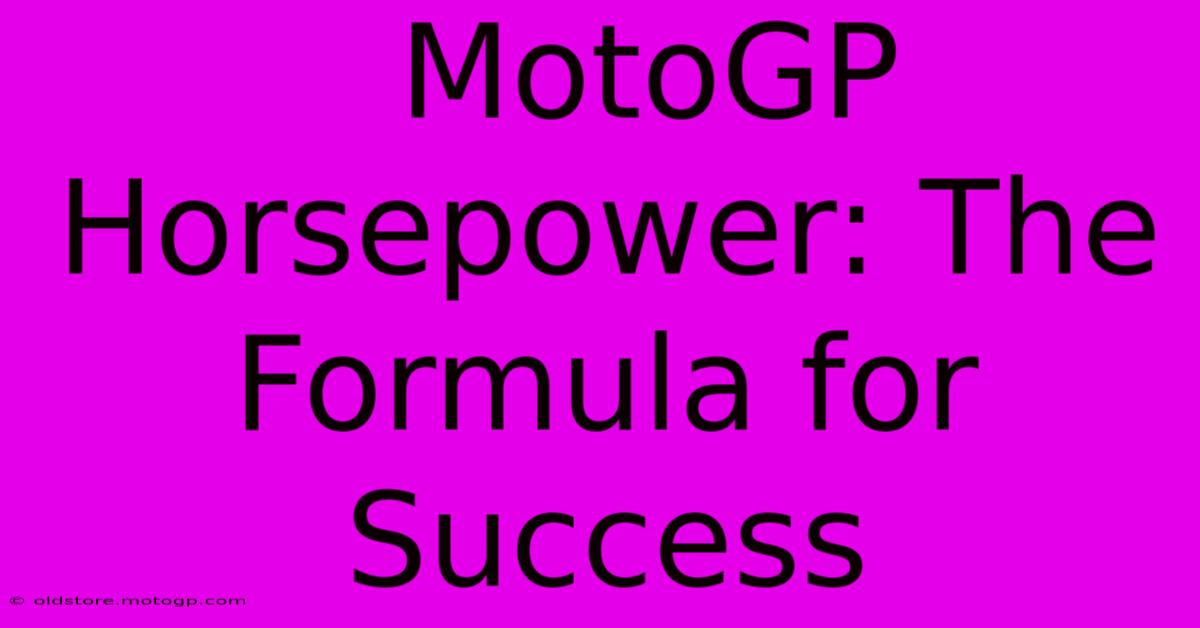MotoGP Horsepower: The Formula For Success

Table of Contents
MotoGP Horsepower: The Formula for Success
MotoGP. The pinnacle of motorcycle racing. The roar of the engines, the breathtaking speeds, the nail-biting finishes – it's a spectacle fueled by incredible horsepower. But what's the secret behind these powerful machines? How much horsepower do MotoGP bikes produce, and what factors contribute to their phenomenal performance? This article delves deep into the horsepower equation of MotoGP, exploring the technology, engineering, and regulations that shape the ultimate racing machines.
Decoding the Horsepower Numbers
Pinpointing the exact horsepower of a MotoGP bike is tricky. Manufacturers are notoriously secretive about precise figures, and the power output can fluctuate based on factors like track conditions, altitude, and engine mapping. However, estimates generally place the horsepower output of a current MotoGP engine well above 260 bhp, some suggesting figures even exceeding 280 bhp. This power is squeezed from a relatively small engine displacement, typically around 1000cc, showcasing the incredible engineering prowess involved.
The Importance of Torque, Not Just Horsepower
While horsepower is a headline-grabbing figure, it's crucial to understand the significance of torque in MotoGP. Torque represents the twisting force of the engine, crucial for rapid acceleration out of corners. MotoGP bikes are engineered to deliver monstrous torque, allowing riders to accelerate with brutal force, making the difference between winning and losing. The power delivery is carefully managed through sophisticated electronics, ensuring the rider can harness this immense power effectively.
The Engineering Marvels Behind the Power
Several key components contribute to the phenomenal horsepower output of MotoGP bikes:
1. Engine Design: A Symphony of Precision
The engines themselves are masterpieces of engineering. They are typically inline four-cylinder engines, precisely balanced for optimal performance and minimizing vibrations. Materials like titanium and magnesium are employed to reduce weight while maintaining structural integrity. Sophisticated technologies like pneumatic valve actuation contribute to higher RPM capabilities and enhanced power delivery.
2. Aerodynamics: Cutting Through the Air
Aerodynamics play a crucial role. The sleek fairings and winglets are meticulously designed to minimize drag and maximize downforce, improving stability at high speeds and allowing the bikes to corner faster. The aerodynamic efficiency contributes significantly to the overall performance by reducing the power lost to air resistance.
3. Electronics: The Brain of the Beast
Modern MotoGP bikes are packed with advanced electronics. Sophisticated traction control, wheelie control, engine braking, and launch control systems all work together to manage the immense power, enhancing rider safety and optimizing performance. These systems dynamically adjust the engine mapping based on track conditions and rider input, ensuring maximum control and power.
4. Fuel and Lubricants: The Life Blood of Performance
High-octane fuel and specialized lubricants are crucial. These fuels are formulated to provide maximum energy density, while the lubricants minimize friction and ensure optimal engine operation under extreme conditions.
The Rules of the Game: MotoGP Regulations
MotoGP regulations play a significant role in shaping the bikes' horsepower. Rules regarding engine displacement, fuel flow, and other technical aspects directly influence the performance capabilities of the machines, creating a level playing field while pushing the boundaries of technological innovation. Understanding these regulations is essential to grasping the complexities of MotoGP horsepower.
Conclusion: A Continuous Evolution
The horsepower wars in MotoGP are far from over. The constant drive for improvement means that the quest for more power and efficiency continues relentlessly. As technology advances, we can expect to see even more powerful and sophisticated machines on the track, pushing the limits of speed and performance further than ever before. The formula for success in MotoGP is a complex blend of horsepower, torque, engineering ingenuity, rider skill, and adherence to the ever-evolving regulations – a captivating combination that defines the sport's thrilling and unpredictable nature.

Thank you for visiting our website wich cover about MotoGP Horsepower: The Formula For Success. We hope the information provided has been useful to you. Feel free to contact us if you have any questions or need further assistance. See you next time and dont miss to bookmark.
Featured Posts
-
Sprint Race Time Your Key To Watching Live
Feb 24, 2025
-
Protect Your Skull How To Identify Counterfeit Motorcycle Helmets
Feb 24, 2025
-
Moto Gp Points System How It Works In Practice
Feb 24, 2025
-
Yamaha V4 Moto Gp A Force To Be Reckoned With
Feb 24, 2025
-
Moto Gp Watch Unforgettable Racing Action
Feb 24, 2025
